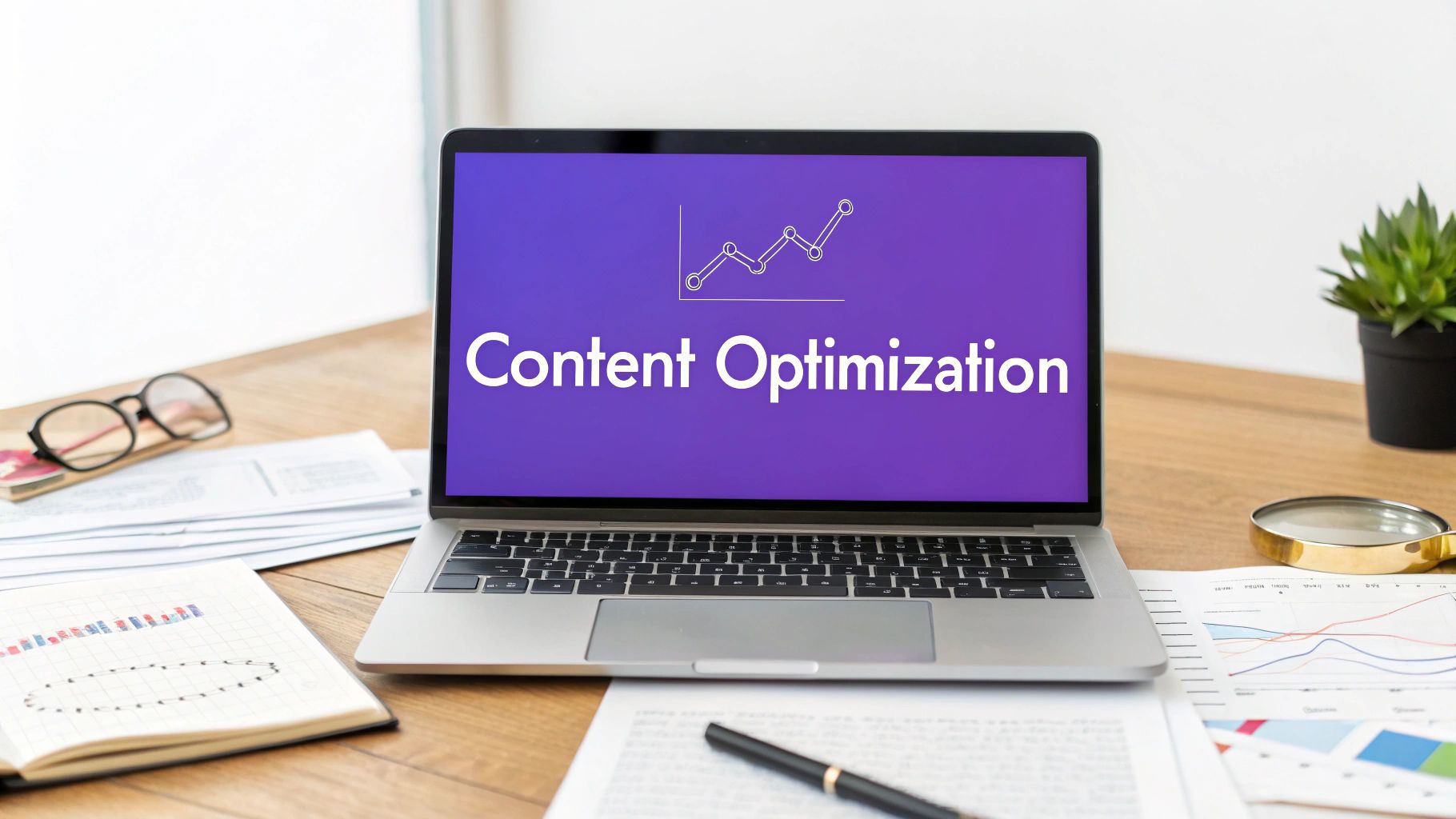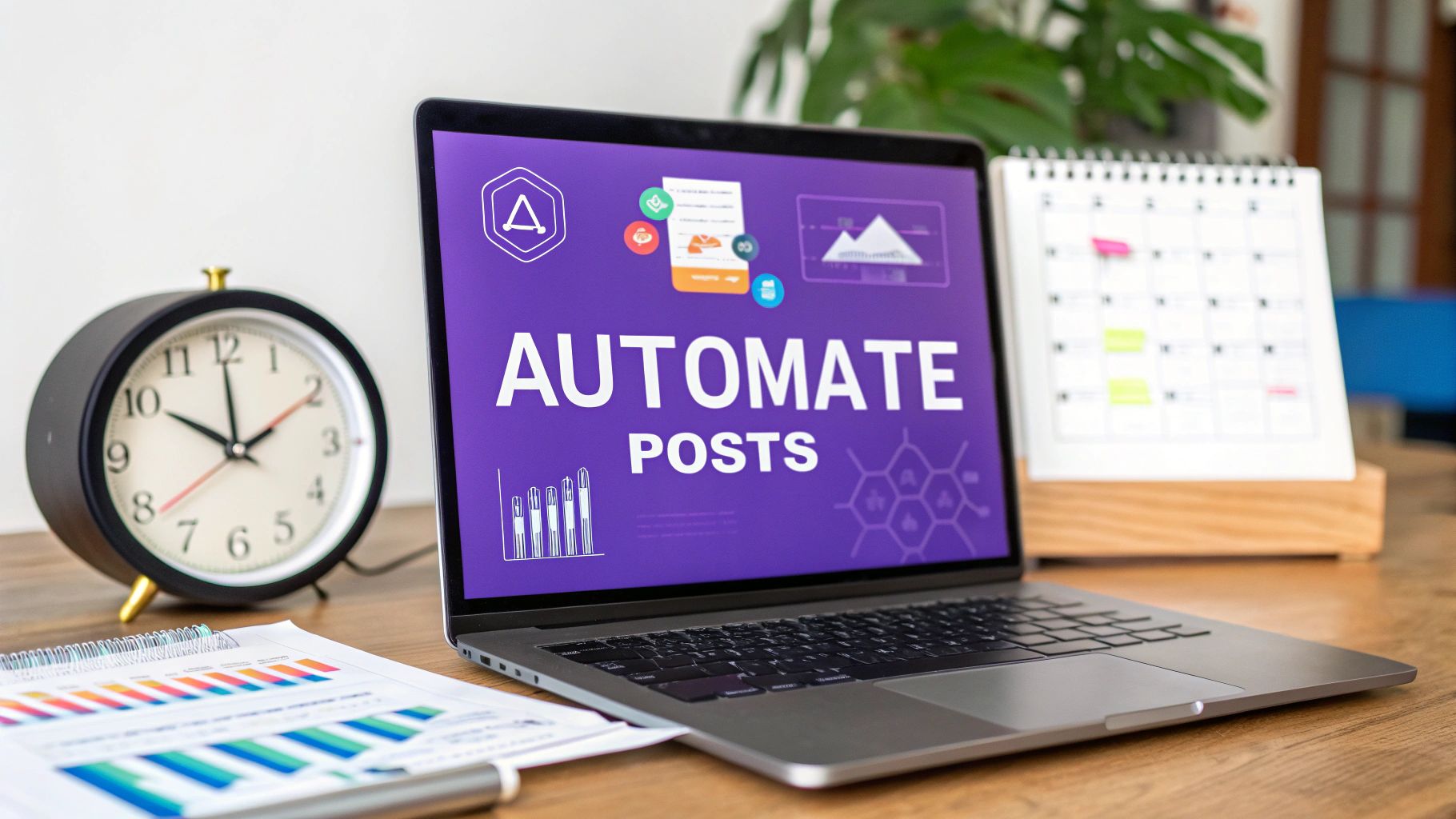Top Conversion Rate Optimization Strategies for 2025
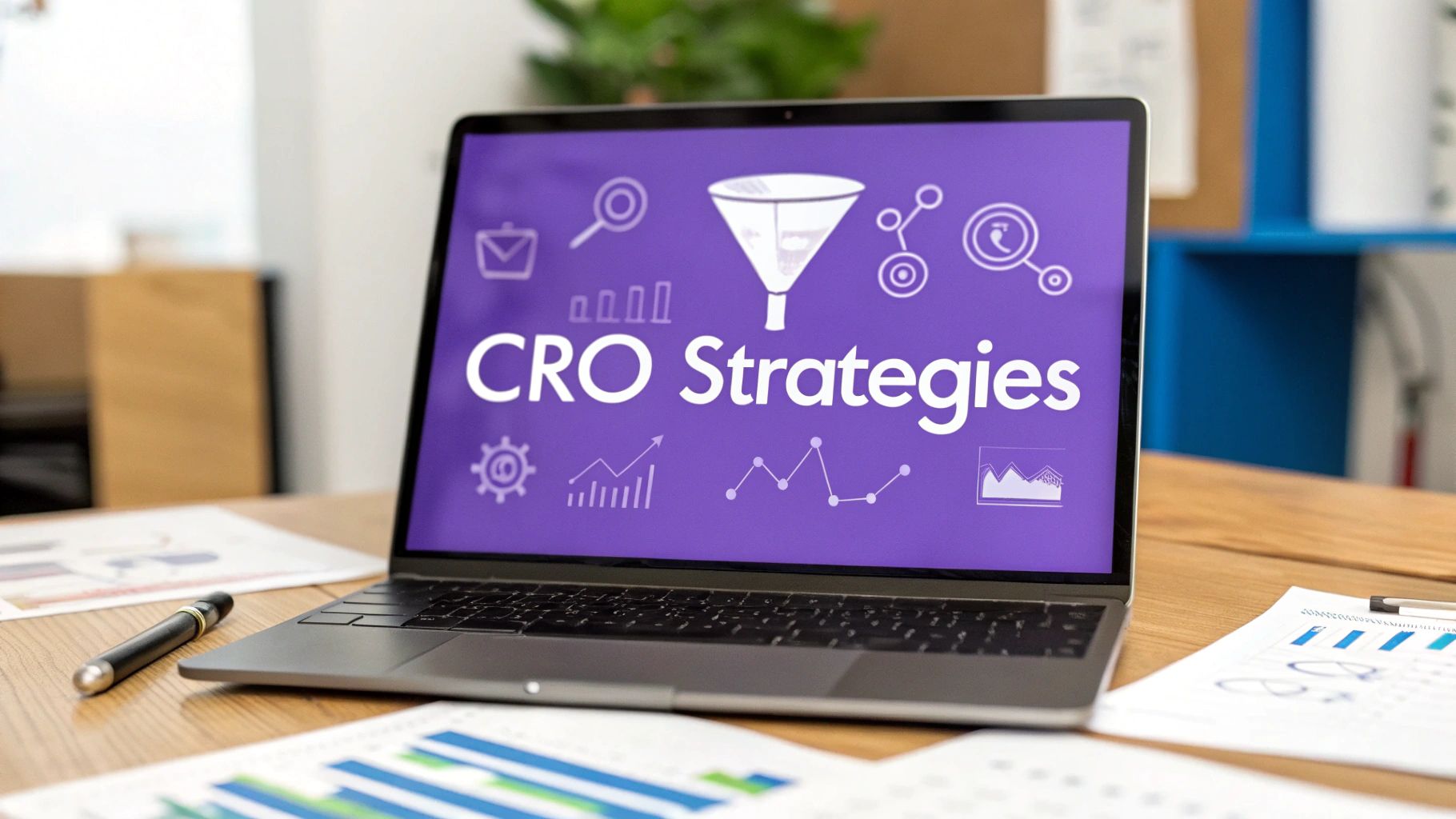
In the competitive digital landscape, driving traffic to your website is only half the battle. The real challenge lies in converting those visitors into loyal customers, subscribers, or leads. This is where Conversion Rate Optimization (CRO) transforms from a marketing buzzword into a critical business discipline. Effective CRO is a blend of art and science: understanding user psychology, analyzing data, and making strategic changes that guide users toward a desired action.
This article moves beyond generic advice to provide a detailed roundup of nine proven, high-impact conversion rate optimization strategies. Each strategy is a powerful lever you can pull to not just incrementally improve, but fundamentally transform your website's performance and bottom line. We'll explore everything from the granular details of A/B testing and CTA design to the broader concepts of value proposition refinement and building trust.
By implementing these actionable techniques, you'll learn how to systematically remove friction, enhance user experience, and create a clear path to conversion. To significantly boost your overall CRO efforts, consider leveraging automation for improving conversion rates, allowing for instant, personal, and consistent lead engagement. Prepare to dive into practical, data-backed methods that turn clicks into customers.
1. A/B Testing (Split Testing)
A/B testing, also known as split testing, is a foundational conversion rate optimization strategy that removes guesswork from website improvements. It is a controlled experiment where you compare two versions of a single web page (Version A, the control, and Version B, the variation) to see which one performs better. By showing each version to a different segment of your audience simultaneously, you can gather empirical data on how changes affect user behavior.
This method allows you to test specific elements like headlines, call-to-action (CTA) button colors, images, or entire page layouts. The goal is to identify which changes lead to a statistically significant increase in conversions, whether that means more sign-ups, sales, or downloads. For instance, HubSpot famously discovered a 24% increase in conversions by changing their CTA button color from green to red, a finding that would have been impossible to confirm without a structured test.
Key Principles for Effective A/B Testing
To ensure your tests produce reliable insights, follow a disciplined approach. Always test one primary variable at a time to clearly attribute performance changes. Run the experiment long enough to capture natural user behavior fluctuations, typically at least one full business cycle, and ensure your sample size is large enough to reach a 95% statistical confidence level before declaring a winner.
The following graphic summarizes the core components of a standard A/B test.
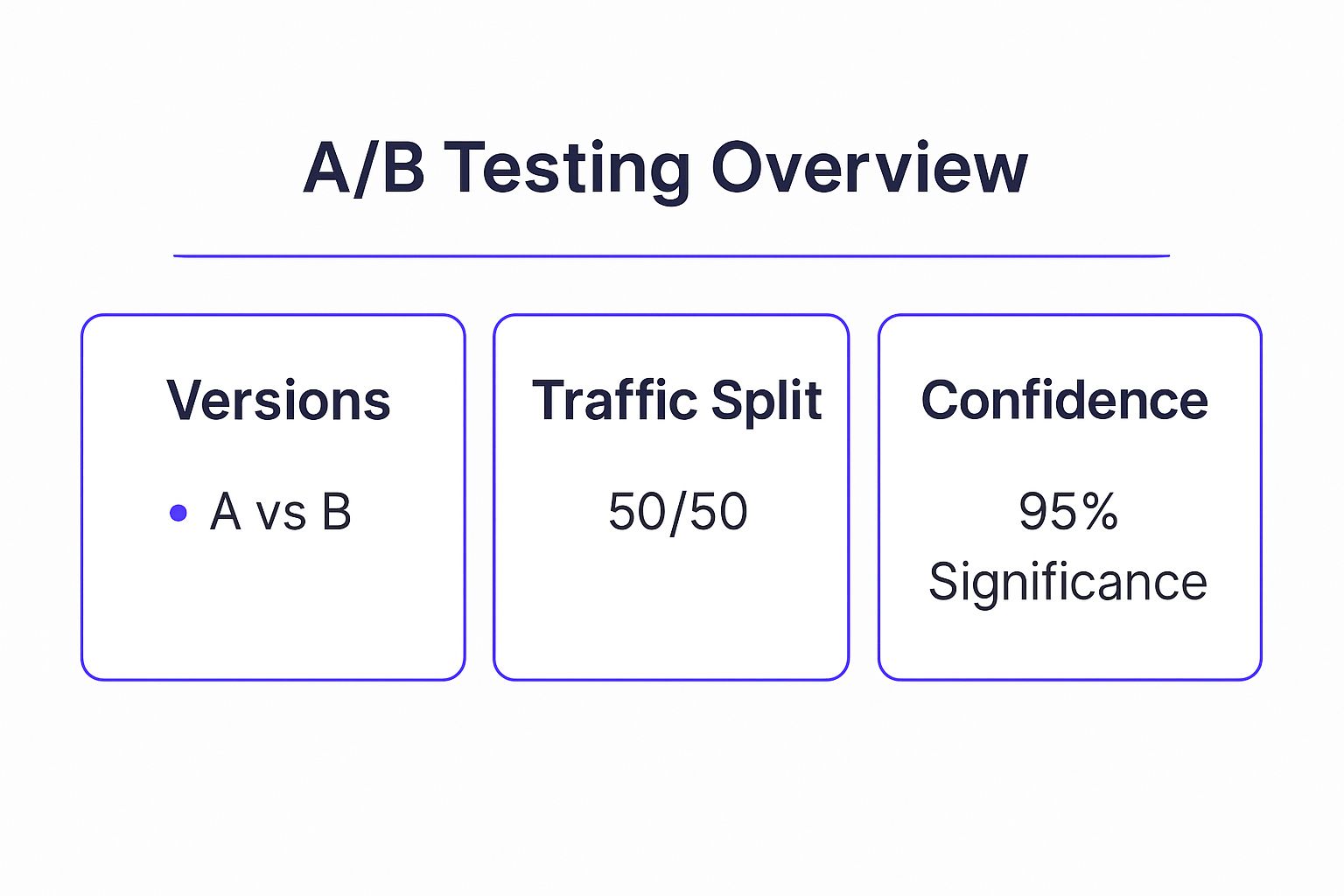
This visual highlights how a test compares two versions by evenly splitting traffic and measuring results until a high degree of statistical certainty is achieved. By documenting every test and its outcome, you build an invaluable library of insights to inform future optimization efforts.
2. Value Proposition Optimization
Value proposition optimization is a critical conversion rate optimization strategy focused on clearly communicating the unique benefit a customer will receive from your product or service. It directly answers the visitor's most important question: "Why should I buy from you and not your competitor?" This strategy involves refining your core message to ensure it resonates instantly with your target audience's needs, desires, and pain points, making your offer feel irresistible.
The goal is to move beyond simple feature descriptions and instead highlight the tangible outcomes and emotional value you provide. A powerful value proposition can dramatically reduce bounce rates and guide users toward conversion. For example, by refining its homepage value proposition to be more benefit-focused, Shopify saw a significant increase in conversions. Similarly, Slack’s simple yet effective "Where work happens" immediately communicates its core function and benefit without jargon.
Key Principles for Effective Value Proposition Optimization
To craft a compelling value proposition, you must deeply understand your customer. Your message should be the first thing a visitor sees, presented with a clear visual hierarchy. It needs to be specific, unique, and directly address a problem. Vague claims like "best-in-class" or "leading solution" are ineffective because they are not provable and fail to differentiate you.
Instead, support your main headline with proof points, such as social proof or key feature benefits. An effective content marketing strategy is essential for articulating this value across all touchpoints. Conduct customer interviews to learn the exact language your audience uses to describe their problems, and test different versions of your value proposition to see which one performs best. Your final message should be so clear that a visitor understands your offer in five seconds or less.
To go deeper, you can explore this content marketing strategy guide to learn how to integrate your value proposition effectively.
3. Landing Page Optimization
Landing page optimization is the process of improving elements on a standalone web page built for a specific marketing or advertising campaign. Unlike a homepage with multiple goals, a landing page has one singular objective: to convert visitors. This strategy involves refining headlines, copy, forms, calls-to-action (CTAs), and layout to create a seamless, persuasive user experience that guides visitors toward a single desired action, making it one of the most effective conversion rate optimization strategies available.
The core principle is message matching, ensuring the landing page's promise aligns perfectly with the ad or link the visitor clicked. By eliminating distractions like site navigation and focusing exclusively on the campaign's goal, you create a powerful, frictionless path to conversion. For example, by removing its sidebar navigation and focusing the user on a single offer, Moz famously boosted conversions by 52%, proving the power of a dedicated, focused page.

Key Principles for Effective Landing Page Optimization
To maximize conversions, your landing page must be built with intent and clarity. Every element should support the primary goal, from the headline to the final CTA click. This requires a deep understanding of your audience, the traffic source, and the core value proposition of your offer.
Here are some core components for an effective landing page:
- Message Match: Ensure the headline and content on your landing page directly reflect the messaging of the ad or link that brought the user there.
- Singular Focus: Remove all unnecessary navigation links, sidebars, and competing offers. The page should have one clear goal and one primary CTA.
- Compelling Copy and Visuals: Use benefit-driven headlines, persuasive copy, and high-quality images or videos that clearly communicate your value proposition.
- Frictionless Forms: Only ask for essential information. Each additional form field can decrease your conversion rate, so keep forms as short as possible.
- Trust Signals: Include social proof like testimonials, customer logos, security badges, and guarantees to build credibility and reduce visitor anxiety.
- Clear Visual Hierarchy: Guide the user's eye toward the most important elements, especially the CTA, using strategic layout, color contrast, and directional cues.
4. Social Proof and Trust Signals
Social proof is a powerful psychological principle where people follow the actions of others in an attempt to reflect correct behavior in a given situation. As a conversion rate optimization strategy, it involves strategically displaying signals that others have trusted and valued your product or service. This reduces friction and anxiety for new visitors by validating their decision-making process. By showcasing testimonials, user reviews, case studies, media mentions, and security badges, you build credibility and make potential customers feel more confident in converting.
This approach leverages our natural tendency to trust the wisdom of the crowd. When a visitor sees that reputable companies or a large number of peers have had positive experiences, their perceived risk diminishes significantly. For example, Booking.com creates urgency and validation with real-time notifications like "5 people are looking at this hotel right now," while Basecamp showcases logos of well-known clients on its homepage to establish immediate authority. This strategy is foundational to building trust, a key ingredient for any successful conversion funnel.
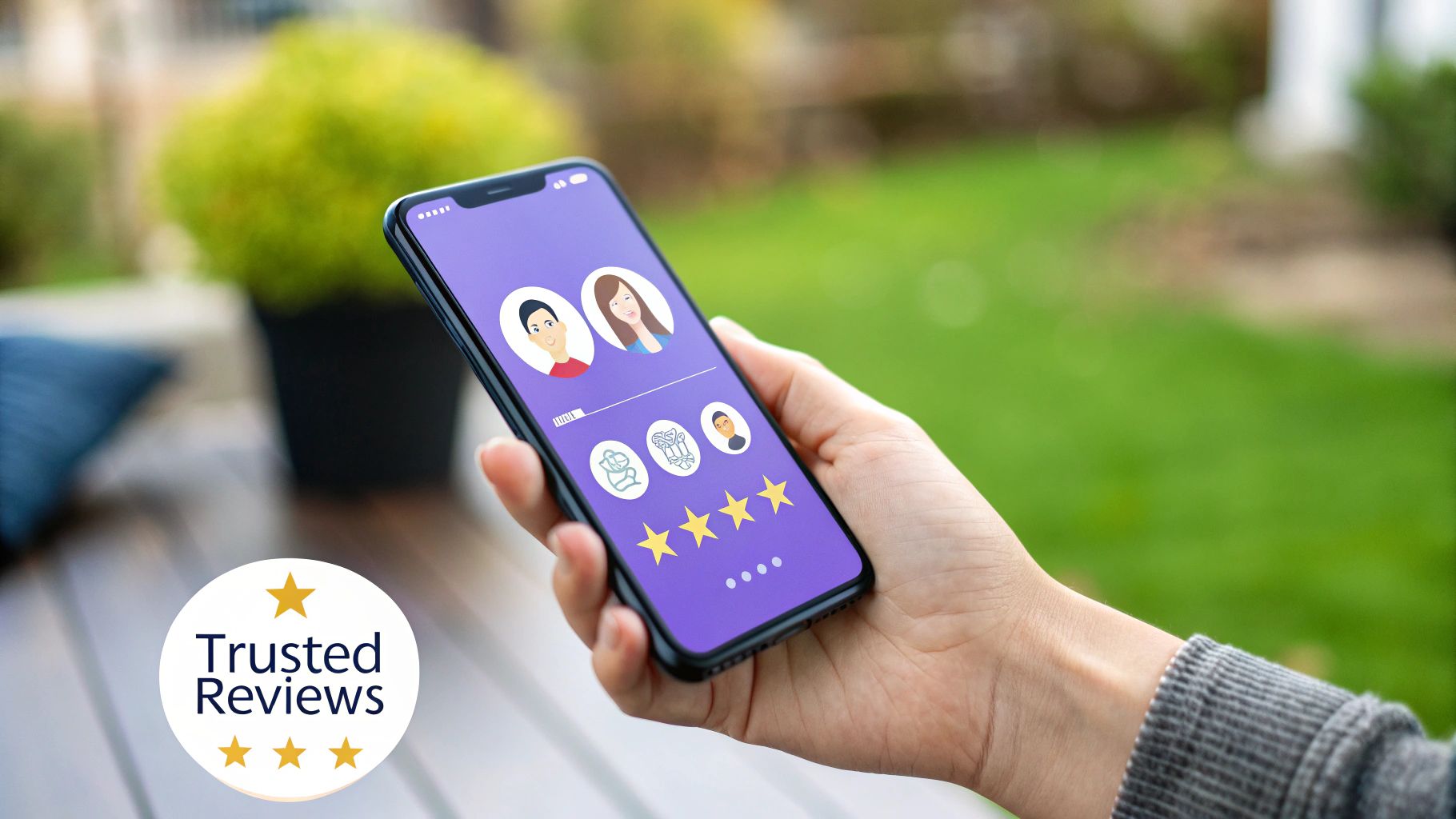
Key Principles for Effective Social Proof
To maximize the impact of social proof, placement and authenticity are crucial. Position these trust signals near high-friction areas, such as pricing pages, checkout forms, and CTA buttons, where users are most likely to hesitate. Always prioritize authenticity; use real names, photos, and specific, outcome-driven testimonials like "We increased lead generation by 40%" over vague praise. To inspire your implementation of trust signals and boost conversions, explore these powerful social proofing examples.
Video testimonials can be particularly persuasive for high-consideration products, while simple star ratings and review counts work well for e-commerce. Displaying impressive user numbers ("Join 2 million satisfied customers") can also be very effective. By consistently reinforcing trust, you create a smoother path to conversion. To dive deeper into the psychology behind this, you can learn more about social proof in marketing.
5. Friction Reduction and Form Optimization
Friction reduction involves systematically identifying and removing any obstacle, hesitation, or complication that prevents a user from completing a conversion. It addresses the small annoyances and barriers in the user journey that, when combined, can significantly increase abandonment rates. A core component of this is form optimization, which focuses on making data entry as effortless as possible for registration, checkout, or lead capture.
This strategy operates on the principle that every extra click, confusing question, or unnecessary field increases the user's cognitive load and decreases their motivation. By streamlining the path to conversion, you make it easier for users to say "yes". For example, Expedia famously discovered that removing a single non-essential field, ‘Company Name’, from their booking form increased their annual profit by $12 million. This illustrates how even minor adjustments are vital conversion rate optimization strategies.
Key Principles for Effective Friction Reduction
To successfully reduce friction, you must view the conversion process through your customer's eyes. Critically evaluate every step and question its necessity. Is this field absolutely essential right now? Could this step be simplified or automated? The goal is to create a seamless, intuitive experience that feels effortless.
- Audit and Eliminate: Scrutinize every form field and remove anything that is not critical for the immediate conversion. HubSpot, for instance, found that reducing their forms from four to three fields increased submissions by 50%.
- Simplify Layout: Use a single-column layout, which is faster for users to scan and complete than multi-column designs. Place labels directly above input fields for clarity.
- Automate and Assist: Implement features like browser autofill, social logins (Google, Facebook), and smart formatting for phone numbers or credit cards.
- Provide Clear Feedback: Use inline validation to show users they have completed a field correctly with a green checkmark, and provide clear error messages if something is wrong.
- Break Down Complexity: For longer forms, break them into a multi-step process and include a progress bar. Marketo used this technique to increase conversions by 10% by making a long form feel less intimidating.
6. Urgency and Scarcity Tactics
Urgency and scarcity are powerful psychological triggers that tap into fundamental human behaviors like loss aversion and the fear of missing out (FOMO). As a conversion rate optimization strategy, this approach creates compelling reasons for users to act immediately rather than later. Urgency introduces time-based pressure through countdown timers and limited-time offers, while scarcity highlights limited availability through low stock indicators or exclusive access.
These tactics effectively shorten the decision-making process by shifting the user’s focus from "Should I buy this?" to "Should I buy this now?". For example, Booking.com famously increases conversions by displaying messages like "Only 2 rooms left!" and "In high demand!" to show real-time scarcity. Similarly, Amazon’s Lightning Deals use highly visible countdown timers to create a sense of urgency that drives significant, time-sensitive sales spikes.
Key Principles for Using Urgency and Scarcity
To leverage these tactics without damaging customer trust, implementation must be both ethical and authentic. The goal is to provide a genuine incentive, not to create false pressure. Always ensure your scarcity and urgency claims are truthful; faking a limited stock or an expiring offer can permanently erode brand credibility.
Combine these triggers with a strong value proposition. A countdown timer is more effective when paired with a clear benefit, such as free shipping or a special discount that will disappear when time runs out. Be specific with deadlines, using exact dates and times like "Offer ends Tuesday at 11:59 PM EST" to create a firm, believable endpoint. This combination of a clear deadline and tangible value gives prospects a powerful and legitimate reason to convert now.
7. Personalization and Segmentation
Personalization is a powerful conversion rate optimization strategy that involves tailoring website content, offers, and user experiences to individual visitors based on their behavior, demographics, or past interactions. Rather than presenting a one-size-fits-all website, this approach dynamically adjusts what users see. By segmenting your audience into distinct groups with shared characteristics, you can deliver highly relevant messaging that resonates more deeply and drives action.
This strategy moves beyond generic communication to create a one-to-one dialogue with each visitor. For example, Amazon’s recommendation engine, a prime example of personalization at scale, is credited with driving a significant portion of its revenue. Similarly, Netflix keeps viewers engaged by personalizing content suggestions based on viewing history. The core principle is that a relevant experience feels more intuitive and helpful, significantly increasing the likelihood of conversion by making users feel understood.
Key Principles for Effective Personalization
To successfully implement personalization, start with a data-driven foundation and expand complexity over time. Begin by creating distinct audience segments based on clear criteria, which requires a deep understanding of your customer profiles. Learn more about how to create detailed buyer personas to inform your segmentation efforts.
Prioritize your efforts by personalizing high-impact pages like the homepage, product pages, or checkout process first. Use behavioral data such as pages viewed, time on site, and past purchases, as it is often the most actionable signal of user intent. You can implement simple tactics like showing different offers to new versus returning visitors or using dynamic content to match landing page headlines with the ad a visitor clicked. This targeted approach ensures your message is always timely and relevant, making it one of the most effective conversion rate optimization strategies available.
8. Call-to-Action (CTA) Optimization
Call-to-Action (CTA) optimization is a critical conversion rate optimization strategy that focuses on refining the buttons, links, and prompts guiding visitors toward a specific conversion goal. Since the CTA is often the final hurdle a user must cross, even minor adjustments can yield significant performance lifts. This practice involves a deep focus on every element, from compelling copy and strategic placement to attention-grabbing design and psychological triggers that maximize click-through rates.
An effective CTA clearly communicates value and reduces friction at the decision-making point. For example, the SaaS company Performable increased conversions by 21% simply by changing their CTA text from "Start your free trial" to "Start my free trial." This small shift to first-person language created a stronger sense of ownership and personal benefit for the user, demonstrating how nuanced language choices directly impact conversion behavior.
Key Principles for Effective CTA Optimization
To transform your CTAs into powerful conversion drivers, a systematic approach is essential. Focus on clarity, urgency, and visual prominence to ensure your call-to-action stands out and effectively communicates what happens next. The goal is to make the desired action the most logical and appealing choice on the page.
- Use Action-Oriented and Specific Language: Start with strong verbs like "Get," "Claim," or "Reserve" instead of passive words like "Submit." Be explicit about the benefit, such as "Download My Free Guide" instead of a generic "Click Here."
- Create Visual Contrast and Hierarchy: Your primary CTA button should pop. Use a color that contrasts with the page background and surrounding elements. Ensure it is large enough to be easily tapped on mobile devices (at least 44x44 pixels).
- Leverage Whitespace and Directional Cues: Generously use whitespace around your CTA to eliminate distractions and draw the user's eye toward it. You can also use subtle visual cues, like arrows or encapsulating shapes, to guide attention.
- Add Benefit-Oriented Microcopy: Reassure users by placing trust-building text near the CTA, such as "No credit card required" or "Join 50,000+ happy customers."
Optimizing CTAs isn't limited to your website; these principles are equally effective in other channels. Learn more about crafting compelling CTAs to boost social media engagement and drive actions across your entire marketing ecosystem.
9. Page Speed and Technical Performance Optimization
In the world of conversion rate optimization strategies, few factors have as direct and measurable an impact as page speed. Page speed optimization is the practice of reducing your website's load time to deliver a near-instant user experience. Slow-loading pages create friction and frustration, leading to high bounce rates and abandoned carts, as users are unwilling to wait. Every millisecond counts, and a faster site is perceived as more professional, reliable, and user-friendly.
This strategy goes beyond simple tweaks; it involves a holistic approach to your site's technical health. Amazon famously calculated that a one-second delay could cost them $1.6 billion in annual sales, while Walmart saw a 2% conversion rate increase for every one-second improvement. These figures demonstrate that technical performance is not just an IT concern but a core business and marketing priority. A fast, responsive website directly supports every other optimization effort by ensuring users actually stay long enough to engage with your value proposition.
Key Principles for Effective Performance Optimization
To achieve a meaningful boost in speed, you must address performance from multiple angles. Start by benchmarking your current performance with tools like Google PageSpeed Insights and GTmetrix, which will provide a diagnostic report and specific, actionable recommendations. The goal should be a load time under three seconds, especially on mobile devices.
Focus on implementing high-impact changes first. Compressing images into modern formats like WebP, minifying CSS and JavaScript to reduce file sizes, and enabling browser caching are fundamental front-end fixes. On the back-end, ensure your server response time is under 200ms and leverage a Content Delivery Network (CDN) to serve assets from locations physically closer to your users. By systematically eliminating bottlenecks, you create a seamless experience that keeps users engaged and moving toward conversion. You can discover more about the tools to monitor these metrics by exploring the top digital marketing tools for small business.
Conversion Rate Optimization Strategies Comparison
| Strategy | Implementation Complexity 🔄 | Resource Requirements ⚡ | Expected Outcomes 📊 | Ideal Use Cases 💡 | Key Advantages ⭐ |
|---|---|---|---|---|---|
| A/B Testing (Split Testing) | Medium - requires traffic and statistical setup | Moderate - analytics and testing tools | Data-driven, statistically significant improvements | Websites with 1,000+ conversions/month for testing specific elements | Eliminates guesswork, measurable ROI, iterative improvement |
| Value Proposition Optimization | Low to Medium - needs deep customer insight | Low - primarily research and messaging | Clear communication of value leading to higher engagement | New products, crowded markets, or customer confusion about offer | Differentiates from competitors, reduces bounce, emotional impact |
| Landing Page Optimization | Medium - design, copy, and technical work | Moderate - design, copywriting, development | Increased conversions, better ad ROI | Paid campaigns, product launches, webinar sign-ups | Focused design, easy to test, dramatic conversion lifts |
| Social Proof and Trust Signals | Low to Medium - collecting and placing content | Low - mainly content creation and management | Increased trust and conversions from 15-400% | E-commerce, high-ticket sales, services with significant purchase risk | Builds credibility quickly, low cost, versatile |
| Friction Reduction & Form Optimization | Medium - design and UX improvements | Low to Moderate - UX, development | Significant conversion lift, less abandonment | E-commerce checkouts, lead capture, registrations | Reduces abandonment, improves UX, quick ROI |
| Urgency and Scarcity Tactics | Low to Medium - content updates and UX tweaks | Low - marketing and messaging | Conversion increase by 20-200%, faster decisions | E-commerce, events, promotions, limited inventory products | Accelerates buying, reduces procrastination |
| Personalization and Segmentation | High - complex data and platform integration | High - data management, technology stack | Large conversion uplift, better relevance | High-traffic sites, diverse audiences, B2B with varied personas | Deeply targeted experiences, boosts loyalty and AOV |
| Call-to-Action (CTA) Optimization | Low - design and copy focused | Low - minimal resources needed | 20-200% conversion increase | Universal - all websites, emails, digital assets | Easy to implement, clear direction, effective final step |
| Page Speed & Technical Performance Optimization | High - technical expertise and ongoing monitoring | Moderate to High - technical staff, infrastructure | Improved conversions, SEO, user satisfaction | All websites aiming for max conversion, especially e-commerce and mobile-first | Reduces bounce, SEO boost, better UX |
From Strategy to Success: Your Path to Higher Conversions
You've just explored a comprehensive toolkit of nine powerful conversion rate optimization strategies, each designed to transform casual visitors into loyal customers. The journey from a stagnant conversion rate to sustained growth isn't about finding a single magic bullet. Instead, it’s about embracing a continuous cycle of improvement, driven by curiosity, data, and a deep understanding of your audience.
The strategies we've covered, from the scientific rigor of A/B testing to the psychological pull of urgency and scarcity, are not isolated tactics. They are interconnected components of a holistic approach. A lightning-fast page speed (Strategy #9) means nothing if your value proposition (Strategy #2) is unclear. Similarly, a brilliant CTA (Strategy #8) will fall flat if your forms are clunky and full of friction (Strategy #5). True success lies in seeing how these elements work together to create a seamless, persuasive, and user-centric experience.
Weaving the Threads Together: Your Action Plan
The path forward can feel overwhelming, but progress is made one step at a time. The key is to move from passive learning to active implementation. Don't try to overhaul everything at once. Instead, adopt a methodical approach that builds momentum and delivers measurable wins.
Here are your actionable next steps:
- Identify the Low-Hanging Fruit: Review your analytics. Where is the most significant drop-off in your funnel? Is it a high-traffic landing page with a low conversion rate? A complex checkout process with a high cart abandonment rate? Start where you can make the biggest impact with the least amount of effort.
- Formulate a Hypothesis: Choose one strategy to begin with. For example, if you suspect your value proposition isn't clear, your hypothesis might be: "By clarifying the headline on our homepage to focus on the primary benefit, we can increase sign-ups by 15%." This gives your test a clear purpose.
- Commit to a Culture of Testing: Whether you're a solo entrepreneur or part of a large marketing team, make experimentation a core part of your operations. Every test, whether it wins or loses, provides invaluable insight into what motivates your users. This cumulative knowledge is the true engine of long-term growth.
Mastering these conversion rate optimization strategies empowers you to do more than just increase revenue. It enables you to build stronger relationships with your customers by truly understanding and serving their needs. You create experiences that feel intuitive, helpful, and trustworthy, turning one-time transactions into lasting brand loyalty. The principles of CRO are a commitment to excellence and a promise to your users that you value their time and attention. Start your journey today, one hypothesis at a time, and watch your strategic efforts blossom into tangible success.
Ready to build the social proof and authority that fuels higher conversions? MakerBox provides AI-powered tools to help you create a powerful, optimized social media presence that establishes trust with your audience from the first impression. Start building your authority and boosting your conversion potential with MakerBox today.


